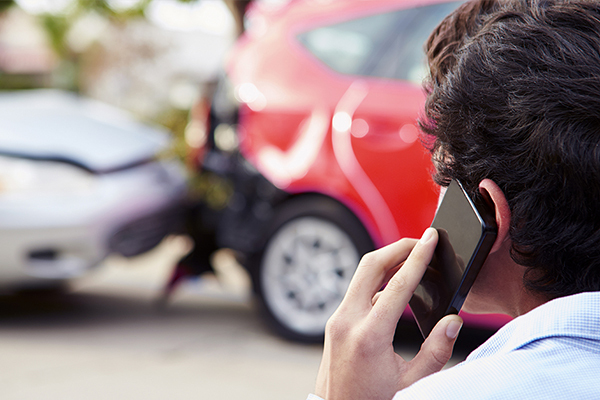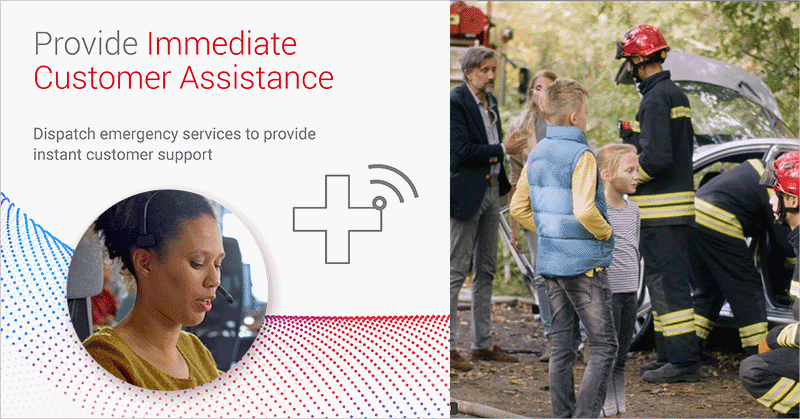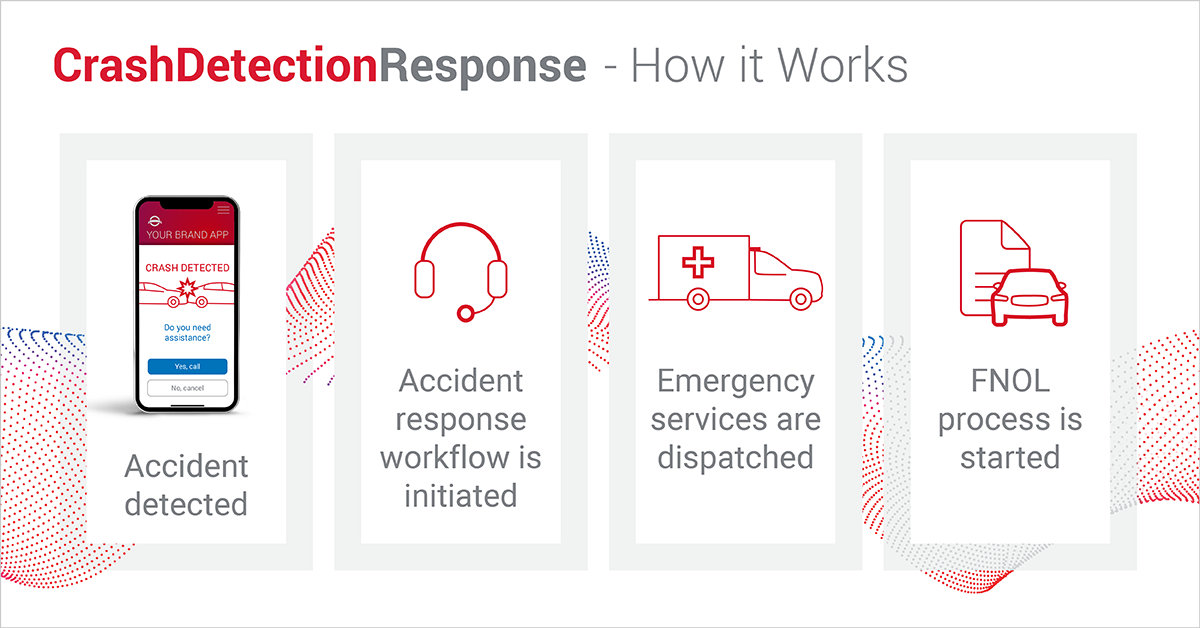Agero Insights

How to Enable Immediate Accident Response Using Telematics
August 19, 2021 | 5 min read
Mobile telematics has been a hot topic for quite a few years, and the rapid technology adoption has been further accelerated by the COVID-19 pandemic. Early adopters in the insurance space have found interesting and compelling use cases for this technology, including new models for rates based on driver safety or mileage. In addition, customer interest in the space has increased dramatically. In an annual survey carried out by Digital Insurance, interest in telematics had only increased roughly 1% each year; following the pandemic, this number increased to nearly 40%. One space that is particularly exciting for mobile telematics is crash detection.
Using telematics technology to detect a crash can have serious benefits to both the insurer and the driver, but only if the technology enables a meaningful response to the crash. Although many solutions exist that detect when an accident has occurred, they do not provide the support drivers need such as contacting emergency services and loved ones. Without the response component, simply detecting the crash also does little to help facilitate quicker claims processes. To truly make an impact for carriers and customers, a crash detection telematics solution requires the ability to respond to an accident by prioritizing support, initiating a claim, and notifying the relevant parties.
What should successful crash detection solutions include?
With 90% of drivers owning smartphones, a solution that can be accessed as a mobile app would maximize the potential market size for mobile telematics. However, some drivers are still wary to install another app, either over concerns about battery usage or reluctance to have their activity tracked, so providing flexible technology options such as an onboard sensor creates even more market potential for crash detection.
Next, and perhaps most importantly, a crash detection solution must be able to provide support for the driver in need. To do this, the solution should be able to check in on the driver after the accident and triage support when needed. This would not only help get the driver to safety faster, but also provides peace of mind knowing that there’s someone looking out for them.
 The crash detection solution should also enable an actionable response from the insurance company. By integrating with an existing accident management platform, the carrier would be notified instantly of an accident, allowing them to immediately create a record. Each accident reported at the scene reduces additional costs incurred from a secondary tow, storage fees, release fees, and other administrative charges, which can add up to as much as $700 - 925 per claim. By enabling more cases to be created at the accident scene through automatic insurance notifications, these costs are now avoided.
The crash detection solution should also enable an actionable response from the insurance company. By integrating with an existing accident management platform, the carrier would be notified instantly of an accident, allowing them to immediately create a record. Each accident reported at the scene reduces additional costs incurred from a secondary tow, storage fees, release fees, and other administrative charges, which can add up to as much as $700 - 925 per claim. By enabling more cases to be created at the accident scene through automatic insurance notifications, these costs are now avoided.
Additional tools can also be included to help streamline the process further. Tools such as smart workflows to expedite information gathering, capturing accident scene photos for more accurate claims, and improved communications to provide transparency are all key elements that can enhance a crash detection offering even more.
By including a response with crash detection, you can reduce your loss cost and expenses while delivering peace of mind for your customers.
Does such a solution exist?
As a matter of fact, yes! Crash Detection Response is Agero’s telematics solution to detect and provide support for accidents. Using our API, we connect your choice of telematics technologies to Agero’s Accident Management platform to deliver immediate, seamless customer assistance and a streamlined accident workflow.
How does Crash Detection Response work?
Crash Detection Response will respond to an event that is triggered from your telematics platform of choice – be it a mobile telematics, OBD-2, embedded sensor, or otherwise. As soon as the crash is detected, our API triggers a workflow to check in on the driver, confirm that they were in a crash, determine whether they are OK or need emergency services, and begin collecting additional details. These accident response steps are crucial to ensure the safety of your drivers and to expedite the claims process. As the accident details are collected, this information is fed into the FNOL report. At the same time, a nearby service provider is contacted and given the crash coordinates to send a tow truck. If the driver is unresponsive or if there are injuries at the scene, our response associates can coordinate emergency services. It can also be configured to trigger a notification to not only the driver’s emergency contacts, but also the carrier.

What are the real-world results and use cases?
One top tier insurance carrier has been using Agero’s Crash Detection Response for well over a year, and the results have been very positive. In the past year, the number of cases created by Crash Detection Response has risen steadily, especially as drivers started returning to the road coming out of the pandemic. In the first year of deployment, the number of accident cases generated by Crash Detection Response rose 280% – that means fewer cases that otherwise would require secondary tows and the associated costs that come with them.
One reason for this growth has been an increased focus on the use of digital tools in the claims process. With the advent of mobile phones being used as an insurance tool, this insurer recognized the opportunity to implement telematics as a means to monitor driving behavior; the ability to detect and respond to accidents using the same technology was a logical next step. By encouraging customers to download their smartphone app, they’re able to offer drivers the benefit of being rewarded for safe driving, while also enabling immediate accident response.
This trend is not isolated to just one client either. As of 2020, 34% of drivers self-identified as being open to telematics-based insurance. And by 2025, its projected that as much as 80% of all claims will be processed virtually, with half of all non-injury FNOL reports being automated. This creates massive opportunity for telematics. According to a merger announcement from leading telematics players (and Agero partners) TrueMotion and Cambridge Mobile Telematics, the mobile telematics market is on track to become a $125 billion market in the next five years. As mobile telematics becomes more pervasive, new use cases for the technology will continue to become available, including assisting with investigations and risk management, providing enhanced data, and implementation with Internet of Things (IoT) and connected cars.
Customers are loving the service too! Many drivers have expressed gratitude that their insurance provider is looking out for them and feel confident that their safety is of paramount importance.
 At Agero, we consider our technology to be one of our strengths, and our Crash Detection Response is a key part of that. By providing the tools to enable immediate action, we’re helping our clients save the day and provide instant support to customers amidst one of their most stressful events: a car accident. We’re happy to help reduce loss cost and expenses but making sure your customers are safe and back on the road is something we’re especially proud to be a part of. Reach out to learn more about Crash Detection Response.
At Agero, we consider our technology to be one of our strengths, and our Crash Detection Response is a key part of that. By providing the tools to enable immediate action, we’re helping our clients save the day and provide instant support to customers amidst one of their most stressful events: a car accident. We’re happy to help reduce loss cost and expenses but making sure your customers are safe and back on the road is something we’re especially proud to be a part of. Reach out to learn more about Crash Detection Response.
Meet the Author: Mubbin Rabbani - Senior Director of Product Management
 Mubbin is Agero’s product and technology lead for the Accident Management business, responsible for delivering innovative solutions that address critical financial levers in the auto claims value chain. He comes from a P&C background, and is passionate about the intersection of process, technology and organizational enablement of the claims experience.
Mubbin is Agero’s product and technology lead for the Accident Management business, responsible for delivering innovative solutions that address critical financial levers in the auto claims value chain. He comes from a P&C background, and is passionate about the intersection of process, technology and organizational enablement of the claims experience.Recent Posts
Auto Industry Leader Tom Feeney Joins Agero’s Board of Advisors
Former Safelite president and CEO to guide Agero’s strategy across technology innovation and...Agero’s Earns Sixth Straight Best Places to Work Award
Annual award honors leading organizations for outstanding workplace culture, employee benefits, and...Agero’s Bob Sullivan Wins 2025 National ORBIE® Award
Recognition marks third consecutive year the esteemed award program has honored Sullivan as an...
